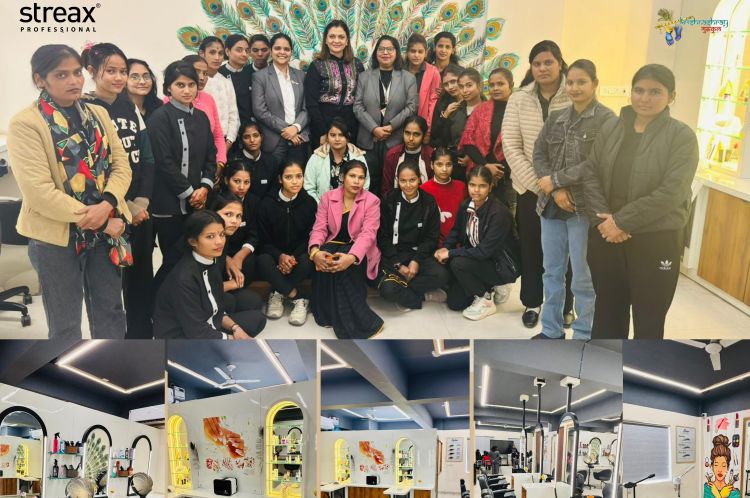India, a country of over 1.4 billion people, is grappling with rapid urbanization, skyrocketing energy consumption and increasingly severe environmental challenges. As the nation’s cities expand and industrialization continues, the massive expanse of concrete plays a crucial role in contributing to the impact of climate change.
However, if done with purpose, green buildings can mitigate the effects of global warming. One promising solution is green architecture, a concept that seeks to minimize the environmental impact of buildings through sustainable design, energy efficiency and the use of eco-friendly materials. Today, India is leading the way in adopting green building practices, positioning itself as one of the world’s frontrunners in sustainability.
With more than 7 billion square feet of certified green building space as of 2023, India is not just meeting the demand for sustainable construction—it is setting global standards. This transformation is driven by a combination of progressive government policies, growing consumer demand for eco-friendly homes and offices, and innovations in building technologies and materials.
A critical factor behind India’s rise as a leader in green architecture is the government’s robust policy framework that actively promotes sustainability. These policies are designed to encourage builders and developers to embrace eco-friendly construction practices, providing both financial and regulatory incentives for those who commit to green building standards.
The growing popularity of green architecture in India has been facilitated by technological advancements that enable the integration of sustainable practices into building designs. These innovations make it possible to reduce energy consumption, minimize environmental impact, and create healthier living spaces.
Consumer Demand: A Shift Towards Sustainability
The growing demand for sustainable living spaces is one of the driving forces behind the rise of green architecture in India. As awareness of climate change and environmental degradation increases, more consumers are actively seeking eco-friendly homes and office spaces. The awareness of green architecture’s benefits—such as lower energy costs, improved air quality, and a reduced environmental impact—is driving this shift in consumer preferences.
According to studies, middle-income consumers in tier-I cities such as Delhi, Mumbai and Bengaluru are willing to pay a premium of 5-10% for green homes. Corporate clients are even more inclined to pay a premium of up to 15% for office spaces that meet green building standards. These premiums reflect the long-term value of green buildings, which can lower operational costs through reduced energy and water usage and improve the health and well-being of the occupants.
In cities like Mumbai, residents have shown a particular interest in sustainability. Research indicates that they are 70% more likely to choose a building with sustainability features, such as energy-efficient designs and access to greenery, compared to residents in other Indian cities. This growing consumer demand is creating a ripple effect, prompting developers to integrate more sustainable features into their projects.
Green Building Policy
Introduced in 2006, India’s Green Building Policy has played an instrumental role in reshaping the construction landscape. The policy aims to make sustainability the standard in new building projects by setting clear guidelines for energy efficiency, water conservation, waste management, and the use of renewable resources. With the ambitious goal of ensuring that all new buildings meet green standards by 2030, the policy is pivotal in shaping the nation’s future development trajectory.
The policy works in conjunction with several other initiatives, including tax incentives for green builders, low-interest loans for energy-efficient projects and fast-track approvals for projects that meet sustainability criteria. These measures not only make green construction more affordable but also streamline the process for developers and encourage faster adoption of eco-friendly practices.
Tax Benefits and Financial Incentives
The Indian government provides several fiscal incentives to developers who construct buildings with LEED (Leadership in Energy and Environmental Design) certification. LEED certification is widely recognized as the benchmark for green building practices and evaluates a building’s environmental performance across several categories, including energy and water efficiency, indoor environmental quality, and material selection.
Developers can avail themselves of tax benefits such as 100% depreciation on investments made in energy-saving technologies, including solar panels, energy-efficient HVAC systems, and rainwater harvesting systems. Additionally, the government offers low-interest loans through organizations like the Indian Renewable Energy Development Agency (IREDA) to support the construction of green-certified buildings. These initiatives provide a financial cushion for developers while encouraging the widespread adoption of sustainable building practices.
In addition to national policies, many Indian states have implemented their own green building incentives. States like Gujarat have introduced additional financial rewards for green certifications, creating a localized, region-specific approach to sustainability. These state-level initiatives help tailor green building strategies to regional contexts, considering local environmental conditions and resource availability.
Renewable Energy Integration
One of the most significant technological shifts in Indian architecture is the integration of renewable energy systems. Solar panels, wind turbines, and geothermal systems are becoming standard features in green buildings, helping to reduce reliance on fossil fuels and decreasing the building's overall carbon footprint. The Indian government also provides tax benefits and subsidies for projects that incorporate renewable energy, further accelerating the integration of these technologies into mainstream building practices.
In addition to on-site renewable energy generation, buildings are increasingly incorporating passive design strategies to enhance energy efficiency. These strategies optimize natural light, air circulation, and temperature control to reduce the need for energy-intensive systems such as air conditioning and artificial lighting. For example, buildings are being designed with larger windows and strategically placed shading devices to maximize natural light while minimizing heat gain, thereby reducing cooling energy costs.
Sustainable Materials
Innovation in building materials is another key factor driving green architecture. Traditional construction materials such as concrete and steel are being replaced or complemented by more sustainable alternatives. For instance, aerated concrete panels, which are lightweight and energy-efficient, are becoming increasingly popular in India’s green building sector. These materials are not only energy-efficient but also reduce the overall environmental impact of construction by repurposing waste materials and minimizing resource consumption.
Recycled materials, such as scrap metal and reclaimed wood, are also being used more frequently in construction, further reducing the carbon footprint of buildings. In addition, there is a growing emphasis on using locally sourced materials to minimize transportation emissions and ensure that construction materials are suited to the local climate and cultural context.
The Rise of Net-Positive Buildings
While net-zero buildings, which aim to balance the energy they consume with the energy they generate, have gained popularity in India, there is a growing trend towards net-positive buildings. These buildings generate more energy than they consume, with surplus energy being fed back into the grid or used for other purposes, such as heating or cooling. This concept represents a paradigm shift in sustainable architecture and goes beyond merely reducing energy consumption to actively contributing to energy production.
Net-positive buildings achieve this feat through the integration of renewable energy systems, highly efficient insulation, and smart building technologies that optimize energy use. By generating more energy than they consume, these buildings play a crucial role in reducing the overall carbon footprint of the built environment and contribute to India’s broader climate goals.
Economic Benefits: A Win-Win for Developers and Consumers
While the upfront cost of constructing green buildings can be higher than traditional buildings, the long-term financial benefits outweigh the initial investment. Research conducted by the India Green Building Council (IGBC) reveals that green buildings can reduce energy consumption by up to 30%, water usage by 30-50%, and maintenance costs by 20%. These savings, combined with the increased durability and longevity of green buildings, make them a sound investment for developers and homeowners alike.
Moreover, green buildings have a significant role in driving the Indian economy toward sustainability. As the demand for eco-friendly buildings grows, the construction industry is seeing a rise in green jobs and the creation of a new market for sustainable materials and technologies. This has the potential to stimulate economic growth while contributing to environmental protection.
The Role of Green Certifications
Green building certifications such as LEED, GRIHA (Green Rating for Integrated Habitat Assessment), and IGBC (Indian Green Building Council) play a critical role in promoting sustainability in India’s building sector. These certifications assess the environmental performance of buildings across a range of factors, including energy efficiency, water conservation, waste management, and the use of sustainable materials.
Basic features of GRIHA
The GRIHA system has been developed to help 'design and evaluate' new buildings (buildings that are still at the inception stages). A building is assessed based on its predicted performance over its entire life cycle – inception through operation. The stages of the life cycle that have been identified for evaluation are:
Pre-construction stage: Issues like proximity to public transport, type of soil, kind of land, where the property is located. Also includes the flora and fauna on the land before construction activity starts, the natural landscape and land features.
Building planning and construction stages: Issues of resource conservation and reduction in resource demand, resource utilization efficiency, resource recovery and reuse, and provisions for occupant health and well-being. The prime resources that are considered at this stage are land, water, energy, air, and green cover.
Building operation and maintenance stage: Issues of operation and maintenance of building systems and processes, monitoring and recording of energy consumption. It also includes occupant health and well-being.
The benefits of GRIHA certification
On a broader scale, the GRIHA system, along with the activities and processes that lead up to it, benefit the community at large by reducing greenhouse gas emissions and reducing energy consumption.
Some of the benefits of a green design are as follows:
- Reduced energy consumption without sacrificing the comfort levels
- Reduced destruction of natural areas, habitats, and biodiversity, and reduced soil loss from erosion etc.
- Reduced air and water pollution (with direct health benefits)
- Reduced water consumption
- Limited waste generation due to recycling and reuse
- Reduced pollution loads
- Increased user productivity
- Enhanced image and marketability
As of 2023, over 14,500 green building projects in India have adopted IGBC ratings, covering more than 12 billion square feet of space. These certifications ensure that buildings meet rigorous environmental standards and provide a tangible benchmark for developers and consumers looking to make sustainable choices.
Traditional Wisdom Meets Modern Innovation
India’s architectural practices often integrate age-old techniques with modern technology. From the use of local, sustainable materials in buildings to passive cooling techniques inspired by traditional designs, Indian architecture emphasizes climate responsiveness. Iconic structures like the Rajiv Gandhi International Airport in Hyderabad, which received a LEED certification for its green design, highlight this blend of tradition and innovation.
Global Partnerships:
Through initiatives like the International Solar Alliance (ISA) and South-South cooperation, India is fostering knowledge-sharing and collaborative action on sustainable infrastructure. The nation’s ambitious target of achieving net-zero emissions by 2070, pledged during COP26, has set a visionary trajectory for its sustainable future. This landmark commitment underscores India’s resolve to balance rapid development with environmental stewardship, offering a roadmap not only for itself but also for the global community. Reinforcing this pledge, the G20’s New Delhi Declaration emphasizes high-level principles for sustainable development, recognizing sustainable infrastructure as a cornerstone of progress.
Community-Centric Infrastructure Development
Sustainability in India often takes a community-first approach. Projects like the rejuvenation of urban lakes in Bengaluru or community-managed water harvesting systems in Rajasthan show how grassroots participation can amplify the impact of sustainable infrastructure. Such initiatives empower local communities while addressing pressing environmental challenges.
Lessons for the World
India’s sustainable infrastructure initiatives demonstrate that it is possible to achieve economic growth without compromising environmental integrity. Key takeaways include:
Integrated Planning: Holistic approaches that blend technology, tradition, and community involvement yield long-lasting results.
Scalability: Even in resource-constrained settings, scaling sustainable solutions is feasible through innovation and policy support.
Global Cooperation: Partnerships, both domestic and international, play a critical role in driving progress.
A Vision for the Future
India’s green architecture movement is still in its early stages, but the momentum is undeniable. With rapid urbanization, increasing environmental awareness, and the growing availability of green building technologies, the future of construction in India is undoubtedly green. As the government, developers, and consumers continue to embrace sustainability, India will not only improve the quality of life for its citizens but also make a significant contribution to global efforts to mitigate climate change.
The goal of achieving 10 billion square feet of green buildings in India by 2035, as outlined by the Indian Green Building Council (IGBC), is within reach. If this vision is realized, India will further solidify its position as a global leader in sustainable development, inspiring other nations to follow suit. Green architecture in India is not just about building more eco-friendly structures; it’s about creating a sustainable future for generations to come.








.jpg)

.jpg)




.jpg)




